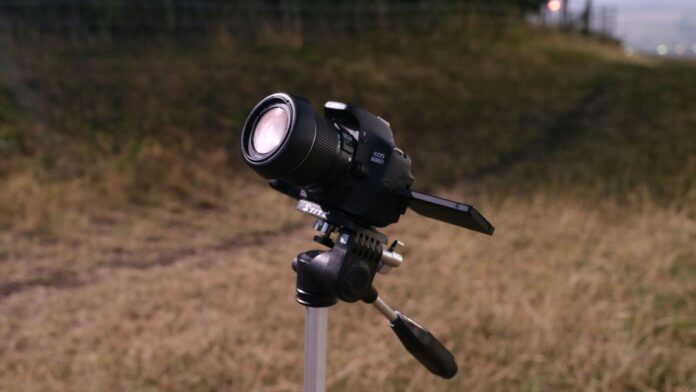Astrophotography is booming thanks to incredible camera advancements like low-light mastery and specialized autofocus designed for capturing celestial wonders. Top brands like Sony, Canon, and Nikon boast cameras capable of breathtaking results under the night sky. But what if your gear isn’t state-of-the-art? Can you still capture stunning images with a “vintage” DSLR?
I recently set out to test this very idea with my trusty Canon EOS Rebel T3i (Canon 600D in Europe and Asia), a camera that’s now 14 years old. The results? Surprisingly impressive! For budding astrophotographers, using an older, more affordable camera is a fantastic way to learn the ropes without breaking the bank.
My Affordable Setup: A Look at What I Used
My setup cost around $500 and relied on accessible gear: a basic beginner’s tripod, my trusty Canon EOS Rebel T3i, and two Canon lenses. The first lens was a standard kit lens – the Canon EF-S 18-55mm f/3.5-5.6 IS II – ideal for wide-field shots of constellations and star fields. My second lens choice was the telephoto zoom Canon EF 70-300mm f/4-5.6 IS USM, perfect for capturing detailed close-ups of the moon.
While not a match for today’s top-of-the-line lenses, this budget combination proves you don’t need the latest and greatest to embark on your astrophotography journey. Used cameras and lenses are often available for a fraction of the cost of brand new mirrorless setups.
Capturing Constellations: A Dance with Noise and Detail
Despite lacking the cutting-edge sensor technology found in newer models, the T3i’s 18MP APS-C sensor managed to deliver surprisingly sharp images of constellations. Paired with the 18-55mm lens, I photographed iconic groupings like Cassiopeia (easily recognizable by its “W” shape), the Alpha Persei cluster featuring the bright star Mirfak, and even glimpsed the faint Andromeda galaxy (M31) tucked away in the corner of one frame.
The classic Big Dipper asterism in Ursa Major stood out brilliantly against the night sky, all seven points of light clearly visible despite some city light pollution. Even fainter stars within the handle of the Dipper, like the star pair Mizar and Alcor, were captured. Another favorite was the Northern Cross asterism in Cygnus; its distinct shape is highlighted by the fainter constellations of Delphinus and Sagitta beneath its left arm and Lyra with its bright star Vega under its right arm. While I didn’t manage to capture a strong image of the Milky Way core – likely due to shooting during a brightly lit gibbous moon phase – this was still a promising start.
A key challenge with older cameras like the T3i is their noise performance in high ISO settings. Increasing the ISO to expose fainter objects introduces noticeable graininess. I also observed slight star trailing when zooming into images, a result of needing longer exposure times. Precise focusing on faint stars proved difficult due to the lack of low-light autofocus and the challenges inherent with using an optical viewfinder.
My workaround? Focusing manually on a bright star like Vega and then carefully pointing my camera towards the target constellation. While not as precise as modern mirrorless cameras, this method still yielded exciting results and allowed me to identify constellations within my photos.
Lunar Detail: A Moonstruck Success Story
The moon is an astrophotography staple – bright enough to handle lower ISOs and minimize noise issues. I mounted the 70-300mm zoom lens on the Rebel T3i and captured a series of detailed lunar shots across different phases. The varying light levels cast dramatic shadows, revealing unique lunar features.
During one moon phase (a waning gibbous), I focused on the Copernicus crater, Oceanus Procellarum (a vast dark plain), and the Mare Serenitatis (a prominent dark region). Shooting in RAW format during editing in Adobe Photoshop allowed me to bring out a remarkable depth of texture across the lunar surface.
On another night, capturing a waxing crescent moon offered incredible detail within features like Mare Crisium and Mare Fecunditatis. Here, I used the full 300mm focal length, maximizing surface detail even when cropping the image to center the lunar disc. Sharpness and contrast remained impressive even after significant cropping.
The EF 70-300mm f/4-5.6 IS USM lens’s built-in image stabilization proved invaluable for capturing these shots handheld – allowing me to adjust focus and exposure settings creatively. Playing with focus points, I created artistic shots by intentionally blurring foreground branches against the bright moon disc or emphasizing sharp detail on the lunar surface while softening the surrounding landscape.
An Unexpected Lesson in Affordability
For beginning photographers, using an older DSLR model like the T3i is a fantastic way to master exposure control, manual settings, and focusing techniques without breaking the bank. It forces you to become intimately acquainted with your camera’s capabilities – a valuable lesson that often gets overlooked when relying solely on automated features.
A Final Verdict: Can You Astrophotograph on a Budget?
The simple answer is yes! While my 14-year-old DSLR presented challenges in handling noise at higher ISOs and accurately focusing on faint objects, these limitations became opportunities for creative problem-solving. The lack of an electronic viewfinder (EVF), which amplifies light for easier viewing, made manual focusing a particularly engaging learning experience – sometimes resulting in blurred shots that became valuable lessons themselves!
It’s worth noting that pairing an older DSLR with a modern star tracker could significantly enhance results, allowing for longer exposures and lower ISOs. Ultimately, astrophotography on a budget proved rewarding. It reinforced the idea that passion, skill, and careful planning are often more important than high-end gear – especially when you’re just starting out. So, if you have an old DSLR gathering dust or want to dip your toes into this captivating hobby without spending a fortune, consider giving it a try! The night sky awaits.

































